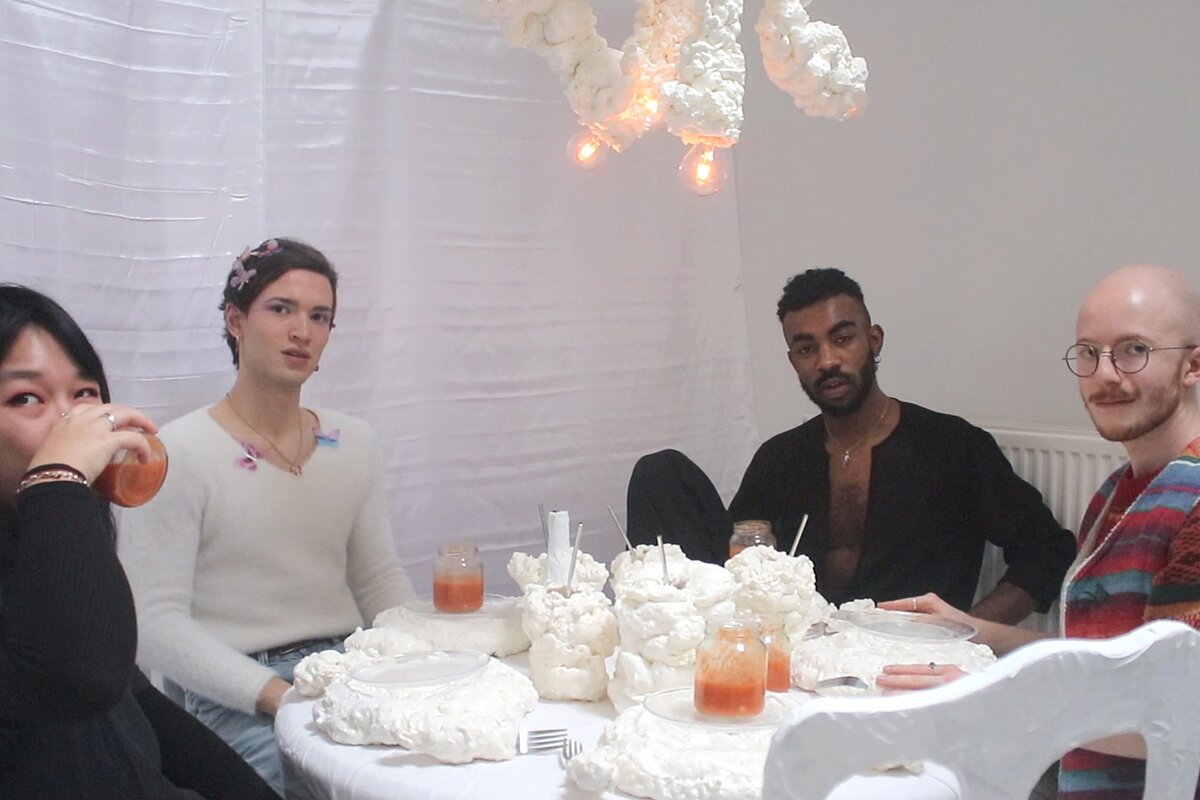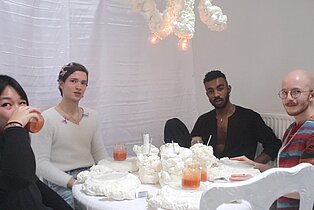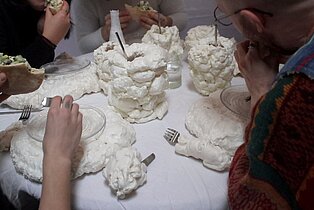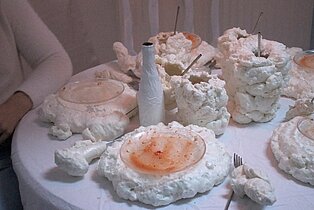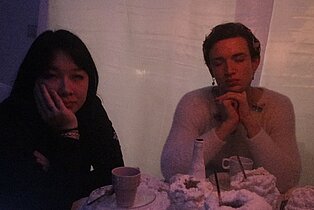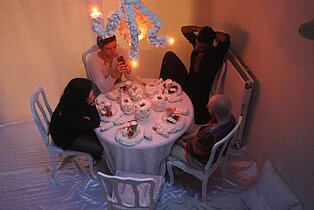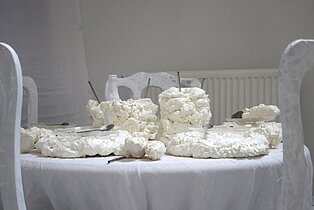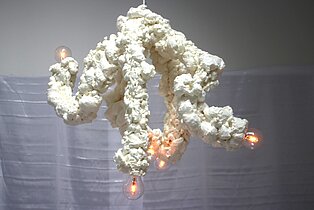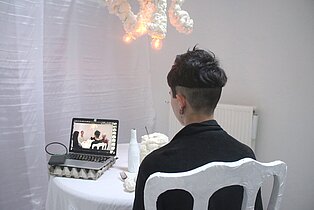Interior Scholarship | Blog 02 | Eff Libilbéhéty [english]
Homo sapiens are no longer proletarian but cognitarians.
To dive into the conscious and unconscious means to fit in society uncovers the fragile balance between the banal and the public. Social appendages, like phones or strategies, are here to lubricate the human’s collision with the external. This liminal space questions the authenticity of each individual and reveals a constraint belonging to the collective. Calling attention to cognitive bias here also relates to how ideology works on a mass of people - because of those human brain’s glitches.
Almost scientifically, these appendages are dissected and archived to offer an object-oriented horizon arising from a different cognitive and perceptual standpoint. Critical moments of resistance are highlighted through domestic rituals. From each of our pre-saved behaviours only remain chairs of wood and bioplastic, as a prosthesis of bipeds’ rooted rituals. As a dialectic between constraint and freedom, the mind and the human-built, each element is a cross-dressing on how expands the Homo sapiens’ body sensoriality.
The subjective identity of the universal human
The excrescences of the social game are a liminal space between every day and the public, the intimate and the chaos. By excrescences I mean all the means homo sapiens use to interact with the external (others, situations, nature, culture, society). As individuals, we try to exist as one but also to fit in the collective. That is called belonging. But this balance between identity and objectivity, or subjectivity and public is not that clear. Humans are wired with the same materials: thoughts, actions, emotions. What creates a melody of these three modules (regulating their interactions) are cognitive bias and constant learning.
Such prosthetics are there to help us make a sense of reality and the world around us, to navigate as sure as we can. They can be tools but also immaterial props, like above-mentioned biases. Their physicality does not matter they are an extension of ourselves, not necessarily practical, neither functional. Just a banal add-on, lubricating our collision with what is outside of the limit, outside our selves.
Bias, for instance, are ‘bugs’ of the human mind and sociability. They are unconscious distortion in how one receives information, potentially leading to irrational decisions or paradoxes. Individuals create their own "subjective reality". Advertising or propaganda, for instance, make great use of our biases because we are often unaware of them and because they are universal (let us see it as a button that provokes similar reactions even though the individuals have very different identities).
They can be explained logically: robotic shortcuts (or mechanical simplification methods) because our brains are unable to comprehend the richness of the whole visual stimuli and chaotic amount of information that the world holds. So, through these means (rationalisation and abstractions), it creates an affordable world and allows itself to navigate through it. Therefore, it is the same on a biological level: the brain does not digest the whole surplus of information happening daily. To find a rhythm in the chaos, it works with pre-established models (based on previous experiences). Basically, a simulation of what is reality screens in our heads, and the only things the brain analyses are the information that does not match with this simulation. These errors are analysed and used to create a more performant simulation, next time.
These social tooling is intangible phenomenon shaping the way we behave. Let us think of religion as an example. For the core of guidance, we created a system of beliefs and rules. Then, finally, things/reality/world had a reason, made sense again. No need to doubt, as there is a precise way to think. We built temples for the core of making sense - temples made of blood and need.
Brain’s models, religion, cell phones. These are excrescences of the human that intend and define how one human relates to another and expands in the world.
Prosthetics to (dis)prove the body
Twenty biases are selected to present all the fragility of the universal human. For instance, the ‘Rhyme as reason’ effect (rhyming statements are perceived as more truthful) or the ‘Law of the instrument’ (an over-reliance on a familiar tool or methods, ignoring or under-valuing alternative approaches. "If all you have is a hammer, everything looks like a nail."). The twenty biases are investigated through experiences to prove or disprove them and will be selected to have ten final ones. Each experience investigates the environment with a new body. As a dialectic between constraint and freedom, an object (chair) is made for each experience. Cross-dressing, transgressive and transcendent, these objects expand the Homo sapiens’ body sensorially. Finally, each experience makes a human feel a sense of liberation. Limiting the objects to a chair also question the form/functions, norms, and standards, present in architecture. To which extent is it still a chair if you cannot sit on it?
Indeed, the chair is a stable element on which humans rely on. It is also a conversational object, one that we all have in our homes. Not only at our homes, as there is a sit for each of our banal rituals. Eating, toilet, public transport, work. The 2021’s humans and their rooted daily lives. A chair for my ass and my thoughts, perfect prosthesis of our daily millimetric ballets. For the fourteen biases, there will be a chair. They are drawn on the papers too. Each chair is as a dialectic between constraint and freedom, cross-dressing on how expands the Homo sapiens’ body sensoriality. My chairs are united by their functions, to simulate the sensorium of a single person but also by two materials.
Each experience is carefully archived (audio, video, notes, and conclusion). Indeed, being filmed creates another context, it is bizarre and performative and emphasizes each of my humans as authentic. Finally, I challenge the person in front of me as a guinea pig and it becomes a number in a research, depersonalized in my archive of human minds.
The diner experience:
Sitting all around a table, everyone is well dressed. Everyone has a role to play. It is no matter which one is the most valuable, but a transient discussion on what it is to be a self and how we do when it encounters other selves. We are offering our more banal performance, seated, and eating. The more we go, the more it appears that all the answers we bring just recall more questions. There is no end, no conclusion, only transitory moments of truth. Rationalisation could not help. From the corn during the Inca civilization to the epigenetic, all is discussed. They think I care about what they are saying, or that it matters. They are eating and I observe them coping with the foam forks. Here to play roles, they got an excuse to be themselves. Unscared of the social game because it is a scenery, they appear. My friends were here, in all their vulnerabilities. Behind performative roles, nothing makes sense. It is all scenery.
The current state of my ignorance
The project somehow aims to help homo sapiens to take a step back on themselves and challenges the viewer to make more sense of the whole instead of just seeing it as a final state. From one side, it shows them they are all a unit made of the same matter. On another hand, it is meant to open one’s eyes from each of their pre-saved behaviours, and thus offers a door to reprogram them. The final room presents experiences/objects/bias, and questions identity, intimacy, and revival. It deploys a new relationship to others and oneself, both gentle and violent, illustrating banal rituals and particular reactions.
Are displayed the ‘chairs’ I made for each person/experience/bias. ‘Chair’ is understood here in a broad way: something to sit, something against a wall to lie on, a rock, etc. Each object is given a number referring to a report. Such a report presents a written translation of the experience, as well as information to (dis)prove bias. Indeed, each experience as a full archive: photos, videos, audio, notes, and objects, as well as results.
In reaction to some situations, individuals generate unconscious distortions. Some sort of bugs in the human brain, but all humans got the same glitches. That is why advertising or propaganda works well. These cognitive biases represent the intricate relationship between the individual and the collective. Each chair is a social sculpture and rethinks human’s affiliation to the group, but also finds new forms of privacy and internal processes.
By being performative, they show all the fragility of the universal human in contradiction with the thought that each human is authentic.


